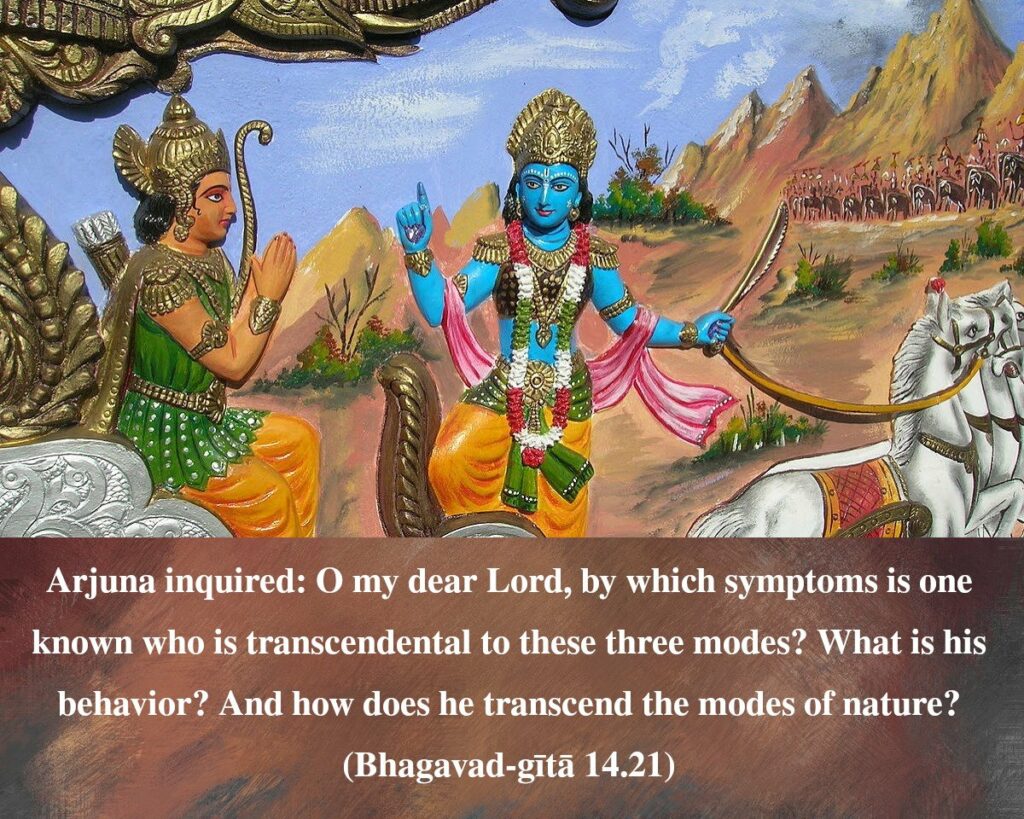अर्जुन उवाच |
कैर्लिङ्गैस्त्रीन्गुणानेतानतीतो भवति प्रभो |
किमाचार: कथं चैतांस्त्रीन्गुणानतिवर्तते || 21||
arjuna uvācha
kair liṅgais trīn guṇān etān atīto bhavati prabho
kim āchāraḥ kathaṁ chaitāns trīn guṇān ativartate
arjunaḥ uvācha—Arjun inquired; kaiḥ—by what; liṅgaiḥ—symptoms; trīn—three; guṇān—modes of material nature; etān—these; atītaḥ—having transcended; bhavati—is; prabho—Lord; kim—what; āchāraḥ—conduct; katham—how; cha—and; etān—these; trīn—three; guṇān—modes of material nature; ativartate—transcend
Translation:
Arjuna said: What are the marks, Ο Lord, of the man who has risen above the three gunas? What is his conduct? And how does he rise above the gunas?
Commentary:
Arjuna naturally wished to know the qualities and conduct of the man who has transcended the Gunas. In the 2nd Discourse also, Arjuna wanted to know the manner and conduct of the Sthitaprajna, and the Lord gave an elaborate discription of the state of the Sthitaprajna. Here also, once again, Arjuna desired to know the character and conduct of the sage who has once ag gone beyond the three Gunas.
Kairlingaih: By what marks can he be distinguished from others? This is a necessary question. For, one comes across quite a good number of imposters and pretenders who are filled with all objective desires, attachments and tendencies any yet who claim to be free and perfect. Such spurious sages and prophets cannot betray the world anymore when we can test their conduct by the Lord’s measuring scale. Further, if the conduct of the real sage is clearly known, the aspirants may strive to follow their example in their own personal conduct and model their life accordingly. Arjuna desires to know the actual way of life followed by the sage who has transcended the three gunas. The description of the Sthitaprajna (Chp.12), of the Jnani (Chp.13), and now of the Gunatita, these are vivid pictures of the conduct of the great sages, bhaktas and Jnanis. By comparison and contrast, one may know where he stands in the scale of spiritual values. The real Sadhu is distinguished from the imposter. Dry philosophy is separated from direct experience. The false atmosphere of spirituality spread over the country shall be dispelled, and true devotion and Jnana shall reign supreme in the hearts of all men.
Kim acharah: A similar question was asked by Arjuna in the second chapter about Sthithaprajna (Kim asita vrajeta kim. Chp. 2). Conduct, practical life is the essence of all religion and philosophy. The Gita particularly insists on practical life according to the highest Truth. This is very essential, for there is the delusion that mere reading of a few religious books is all that is needed to become a Jnani. Such false notions have left people mere theoreticians, who quail and fail by the least crisis of loss and bereavement. While asserting that Atma is deathless, people tremble at the thought of death. While asserting that the world is an illusion, people desperately cling to all their positions and possessions. This is not practical religion. In fact, religion is intended to lift man out of all the fearful delusions of life. When this is not realised, religion remains as mere talk and nothing more. That is why the Gita wants to test man’s wisdom or devotion by practical conduct in everyday life.
Moreover, while it is necessary to know the goal clearly, it is even more necessary to know the path leading to the goal with perfect clearness. When once the goal is fixed, all that is needed is practice (sadhana). When the place to reach is decided the next thing is to know the way leading to it. There is no use in thinking of the destination always without starting on the journey. When the journey begins and continues the destination is reached automatically. When the Sadhana is sincere and truthful, the Sadhya is realised of its own accord. So the Gita lays more emphasis on Sadhana than Sadhya. The supreme goal is stated briefly, and the path leading to it elaborately. This is the special distinction of the Lord’s teaching.
The Lord’s answer to Arjuna’s question is one of the most illuminating parts of the Gita. Those who aspire for liberation should study, understand and practice this aspect of the Gita message.
Question: What did Arjuna want to know from the Lord?
Answer: 1. The marks of the Gunatita, and 2. his conduct.
Bhagavad Gita: Chapter 14 🔻 (27 Verses)
